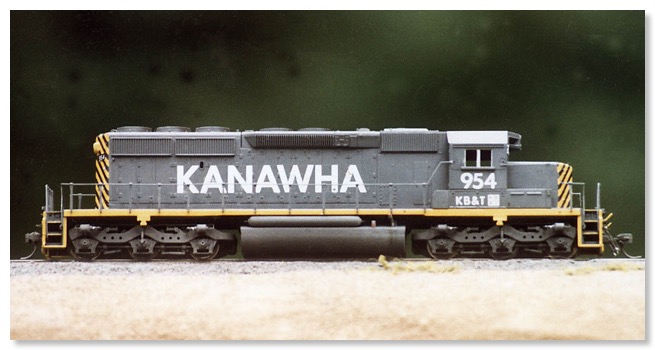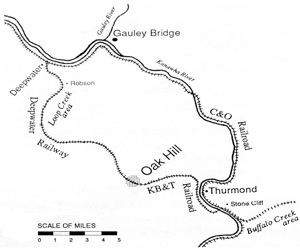
KB&T, a short history —
In the spring of 1898, the Kanawha, Buffalo & Thurmond (KB&T) began laying 3 miles of rail on the north side of West Virginia's Kanawha River near Buffalo Creek. At the mouth of Buffalo Creek the line turned down stream following the Kanawha River for about 2½ miles to the community of Stone Cliff where it bridged the Kanawha River. The line then continued along the south bank for another 2 miles to the mouth of Arbuckle Creek, just across the river from Thurmond, West Virginia. The KB&T then followed Arbuckle Creek 3 miles to Oak Hill where it connected with the Deepwater Railroad which was then building south along Loop Creek from a terminus at the small community of Deepwater on the Kanawha River. When the Fall of 1899 arrived, the KB&T had bridged the Kanawha east of Thurmond and completed its connection with the Deepwater at Oak Hill.

The Kanawha, Buffalo & Thurmond operated for almost 14 years as a quiet shortline adding a mine here and there along its 10½ mile line. It delivered coal to the Virginian, successor to the Deepwater, at Oak Hill Junction (OH) and carried mining supplies to the mines along Buffalo and Arbuckle Creeks.
In 1917, the KB&T negotiated trackage rights on the Virginian from Oak Hill Junction to the Virginian’s bridge across the Kanawha River at Deepwater. The bridge had been completed in 1909 at a cost of $300,000. On the north side of the river the Virginian connected to the Kanawha & Michigan (K&M) and thereby to the mid-west. Eight years later these trackage rights would play an important part in the growth of the KB&T from a shortline into a significant regional railroad.
In the summer of 1925, the Norfolk & Western proposed a merger with the Virginian, but government officials in Virginia were opposed and convinced the Interstate Commerce Commission to deny the merger. In November 1925, the Kanawha, Buffalo & Thurmond was successful in its bid to buy a controlling interest in the Virginian. The two railroads maintained separate identities until after the Second World War
In 1946 management decided to combine both roads under the KB&T reporting marks. Thus a new railroad emerged with 747 miles of main line stretching from Toledo, Ohio, to Hampton Roads, Virginia. Major branch lines included the Elk River Subdivision from Charleston, W. Va. to Elkins, W. Va. and the Guyandotte Subdivision from Elmore, W.Va. (Gulf Junction) to Gilbert, W.Va. where the former Virginian had a C&O interchange.
The combined railroads were called the “Kanawha”, the name by which the Kanawha, Buffalo & Thurmond had long been known among locals.


